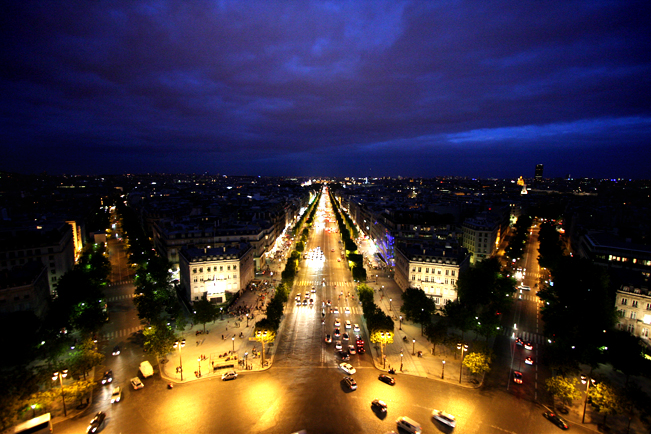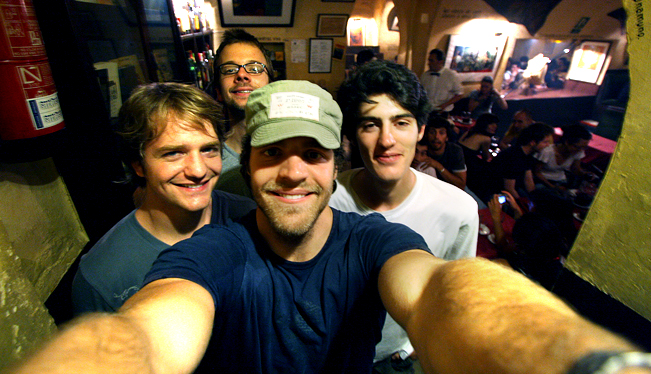On the train to Madrid, Tyler struck up a conversation with some Spaniards and discovered that the festival of San Fermin, or the running of the bulls, was still happening. For Tyler the running of the bulls represents the pinnacle of what a trip like this should be for a few reasons. First, we had to modify our schedule and timeline for the trip in order to make it to Pamplona, which instantly creates adventure. Second, running with the bulls is inherently dangerous, so it’s exciting. Third, everybody has heard of it so we will all be able to tell a great story about it someday.
Getting to Pamplona turned out to be much more involved than a three-hour train ride. In Madrid I was waiting for Tyler and Joey in a café, working on this very blog, oblivious to the time, when they rushed in scrambling, new white clothes for the bull run in hand, asking me why I wasn’t ready to go. It turned out we only had 20 minutes to make it to the apartment we were staying in, collect our things, make it to the train station, buy our tickets, go through security, and board the train. Clearly we didn’t think this through.
After sprinting through a metro station, after bounding up the stairs, after flagging down a cab, after speeding to the train station, after Tyler had to run down the same cab to reclaim his camera, after running full speed with all our gear to the ticket office, after panting in line waiting for tickets, after hurtling to the train and through security, we arrived on the train panting and soaking with sweat, claiming we would never do such a thing ever again. Somehow we had made it.
We arrived in Pamplona on the last night of the 8-day festival, so everyone there looked a little weary. Their white pants and shirts were dusty. Their red scarf’s and sashes a little rough around the edges. The night before the last run we walked around the city square to take in the festival itself and to eat some dinner. What we saw was men and women throwing up and urinating in alleyways, and many weary people who had been drinking nonstop for over a week. I knew then why people were gored by bulls—they could barely stand, much less walk, let alone run from a bull.
So we decided to sleep, so that we would be nice and rested for the bull run the next morning.
After waking up at 6:30 and groggily making our way through the streets, we saw the erected barriers that formed the path for the bulls to run. People were everywhere, sitting along and atop the barriers, milling in the rain soaked streets, accumulating in masses all around the path of the bulls. Most people it seemed hadn’t slept at all, so they weren’t hung over but still drunk. I expected a blood bath, so Joey and I found a perch to take it all in. I decided to videotape Tyler’s exploits instead of running, and Joey thought taking pictures would be a better use of his time.
Tyler ran with the bulls indeed, but we missed watching him do it, partly because the whole thing lasted about two minutes, and mainly because Tyler ended up starting ahead of our vantage point. At exactly 8 am a canon blasted and the runners in front of us started sprinting down the street. After about thirty seconds, we saw a group of 13 bulls or so, trotting (that’s right, trotting, not running) past us. And like that it was over. No one was trampled. I saw no one gored. It was just some bulls trotting down the street.

Tyler claims that one of the bulls was a mere couple of feet from his right side, but I’m not sure. You never know with Tyler.

Of course, my favorite parts of the event were cerebral, mostly because when we perched ourselves on a concrete ledge 40 minutes before the running, I had a lot of time to think. I fantasized about jumping from 10 feet above on top of a would be thief who would surely attempt to take Joey’s bag of lenses. But it never happened, so I directed my thoughts elsewhere, and as it happened while we were waiting we saw a man who looked remarkably similar to Ernest Hemingway.

This was pure serendipity. While not detracting from the media coverage of gorings and tramplings at the running of the bull’s, I have to say that any American who was at that festival was there, directly or indirectly, because of Hemingway’s portrayal of the event in The Sun Also Rises. He made this festival famous. I find this vastly interesting because ostensibly the festival venerates the patron saint of Pamplona, Saint Fermin, but it didn’t feel Christian at all. That’s not to say that it wasn’t religious—it was wrought with ceremony and ritual. After all bullfighting has its roots in pagan sacrifice, and the week long drunken revelry certainly felt like it was rooted in paganism. So by my count most people who were there were a few steps removed from anything having to do with the original reasons for the festival. Some were there because of Papa Hemmingway, possibly chasing some sort of validation in terms of his definitions of masculinity. And some were there just to drink and to have a good time. So why were we there?
We were there for a good story.
Travelers are story chasers and a trip finds completion in the telling and retelling of your exploits. But as I’ve thought about this motivation to travel, I have to ask myself, am I looking at and experiencing these things because I am moved by them and am learning something about life and humanity from them? Or am I simply marking them off a list so that I can feel culturally significant?
That may seem harsh, but it does come down to this simple question—do I experience the thing in the moment or do I experience it later when I get to tell someone I saw such and such painting? Obviously, there is a little bit of both. Certainly it isn’t wrong to share experiences with people. A vital aspect of travel is the social ceremony of sharing your experiences with others when you return. As all of us have noted on this trip, certain things don’t feel real until you talk about them with people that you care about. For the most part, people want to see your pictures and hear your stories. But there is a fine line between the communal sharing of experience and cashing in the cultural cache you’ve accumulated by being a world traveler. I’m still trying to figure out where I fall on that spectrum.
For more pictures from our adventures, go to Joseph’s website.
































